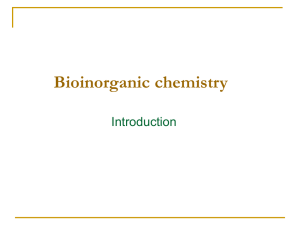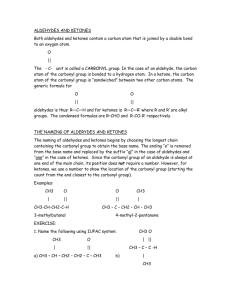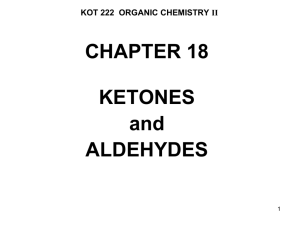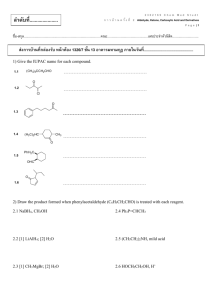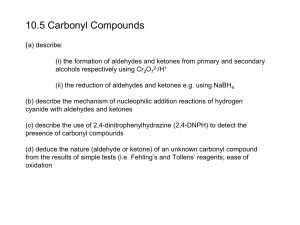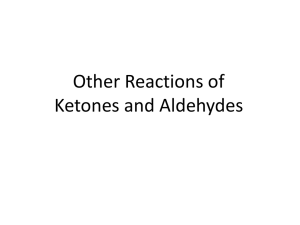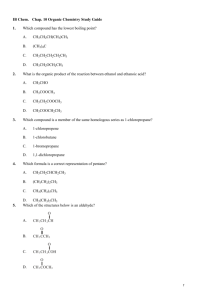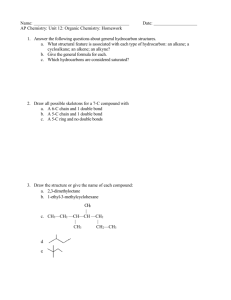Chapter 18 Ketones and Aldehydes - chemistry
advertisement
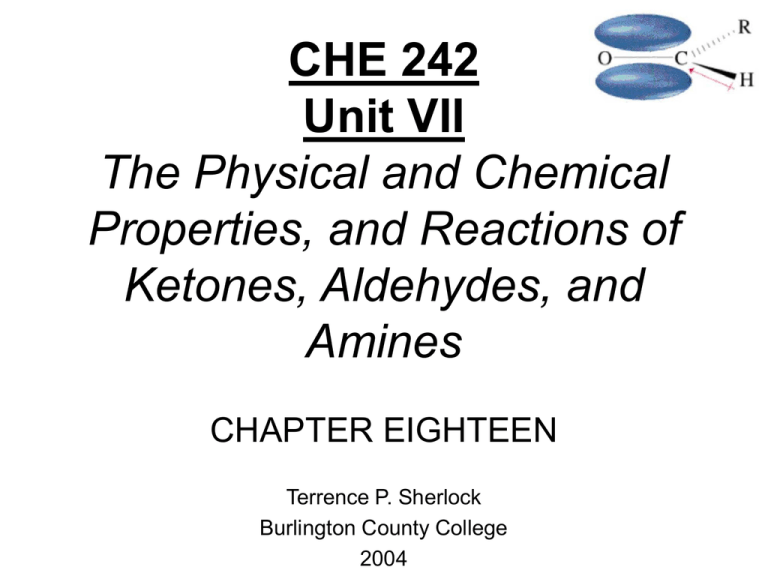
CHE 242 Unit VII The Physical and Chemical Properties, and Reactions of Ketones, Aldehydes, and Amines CHAPTER EIGHTEEN Terrence P. Sherlock Burlington County College 2004 Carbonyl Compounds => Chapter 18 2 Examples O O CH3 C CH CH3 CH3 3-methyl-2-butanone Br 3-bromocyclohexanone O CH3 C CH CH2OH CH3 4-hydroxy-3-methyl-2-butanone => Chapter 18 3 Name as Substituent • On a molecule with a higher priority functional group, C=O is oxo- and -CHO is formyl. • Aldehyde priority is higher than ketone. COOH CH3 O CH3 O C CH CH2 C H 3-methyl-4-oxopentanal CHO 3-formylbenzoic acid Chapter 18 => 4 Historical Common Names C O CH3 O CH3 C CH3 acetophenone acetone O C benzophenone => Chapter 18 5 Aldehyde Common Names • Use the common name of the acid. • Drop -ic acid and add -aldehyde. 1 C: formic acid, formaldehyde 2 C’s: acetic acid, acetaldehyde 3 C’s: propionic acid, propionaldehyde 4 C’s: butyric acid, butyraldehyde. => Chapter 18 6 Boiling Points • More polar, so higher boiling point than comparable alkane or ether. • Cannot H-bond to each other, so lower boiling point than comparable alcohol. => Chapter 18 7 Solubility • Good solvent for alcohols. • Lone pair of electrons on oxygen of carbonyl can accept a hydrogen bond from O-H or N-H. • Acetone and acetaldehyde are miscible in water. => Chapter 18 8 Formaldehyde • Gas at room temperature. • Formalin is a 40% aqueous solution. H H O H C O O C C H O H H heat H C H H2O formaldehyde, b.p. -21C trioxane, m.p. 62C HO OH H C H formalin => Chapter 18 9 IR Spectroscopy • • • • Very strong C=O stretch around 1710 cm-1. Conjugation lowers frequency. Ring strain raises frequency. Additional C-H stretch for aldehyde: two absorptions at 2710 cm-1 and 2810 cm-1. => Chapter 18 10 1H NMR Spectroscopy => Chapter 18 11 McLafferty Rearrangement • Loss of alkene (even mass number) • Must have -hydrogen => Chapter 18 12 UV Spectra, * • C=O conjugated with another double bond. • Large molar absorptivities (> 5000) => Chapter 18 13 UV Spectra, n * • Small molar absorptivity. • “Forbidden” transition occurs less frequently. => Chapter 18 14 Synthesis Review • Oxidation 2 alcohol + Na2Cr2O7 ketone 1 alcohol + PCC aldehyde • Ozonolysis of alkenes. R' H C C R R'' R' H 1) O3 2) (CH3)2S C O R + O C R'' => Chapter 18 15 Synthesis Review (2) • Friedel-Crafts acylation Acid chloride/AlCl3 + benzene ketone CO + HCl + AlCl3/CuCl + benzene benzaldehyde (Gatterman-Koch) • Hydration of terminal alkyne Use HgSO4, H2SO4, H2O for methyl ketone Use Sia2BH followed by H2O2 in NaOH for aldehyde. => Chapter 18 16 Ketones from Nitriles • A Grignard or organolithium reagent attacks the nitrile carbon. • The imine salt is then hydrolyzed to form a ketone. N MgBr C N CH3CH2MgBr + C ether CH2CH3 O H3O + C CH2CH3 => Chapter 18 17 Aldehydes from Acid Chlorides Use a mild reducing agent to prevent reduction to primary alcohol. O CH3CH2CH2C O Cl LiAlH(O-t-Bu)3 CH3CH2CH2C H => Chapter 18 18 Ketones from Acid Chlorides Use lithium dialkylcuprate (R2CuLi), formed by the reaction of 2 moles of R-Li with cuprous iodide. 2 CH3CH2CH2Li CuI (CH3CH2CH2)2CuLi O (CH3CH2CH2)2CuLi + CH3CH2C Cl O CH3CH2C CH2CH2CH3 => Chapter 18 19 Nucleophilic Addition • A strong nucleophile attacks the carbonyl carbon, forming an alkoxide ion that is then protonated. • A weak nucleophile will attack a carbonyl if it has been protonated, thus increasing its reactivity. • Aldehydes are more reactive than ketones. Chapter 18 20 => Wittig Reaction • Nucleophilic addition of phosphorus ylides. • Product is alkene. C=O becomes C=C. Chapter 18 21 => Addition of HCN • HCN is highly toxic. • Use NaCN or KCN in base to add cyanide, then protonate to add H. • Reactivity formaldehyde > aldehydes > ketones >> bulky ketones. O CH3CH2 C HO CH3 + HCN Chapter 18 CH3CH2 CN C CH3 22 => Other Condensations Chapter 18 23 => Addition of Alcohol => Chapter 18 24 Acetals as Protecting Groups • Hydrolyze easily in acid, stable in base. • Aldehydes more reactive than ketones. O O CH2 CH2 OH HO C H + H C O O O => Chapter 18 25 Selective Reaction of Ketone • React with strong nucleophile (base) • Remove protective group. + _ MgBr O CH 3 O HO CH3MgBr C O O H3O C O O CH3 + C H O => Chapter 18 26 Oxidation of Aldehydes Easily oxidized to carboxylic acids. => Chapter 18 27 Tollens Test • Add ammonia solution to AgNO3 solution until precipitate dissolves. • Aldehyde reaction forms a silver mirror. O R C H+ + NH3)2 _ + 3OH 2 + Ag(NH3)2 _ + 3OH O H2O O H2O 2 Ag + R C O _ 2 Ag + R C O + _ + 4 NH3 + 2 H2O => Chapter 18 28 4 Reduction Reagents • Sodium borohydride, NaBH4, reduces C=O, but not C=C. • Lithium aluminum hydride, LiAlH4, much stronger, difficult to handle. • Hydrogen gas with catalyst also reduces the C=C bond. => Chapter 18 29 Catalytic Hydrogenation • Widely used in industry. • Raney nickel, finely divided Ni powder saturated with hydrogen gas. • Pt and Rh also used as catalysts. O OH Raney Ni H => Chapter 18 30 Deoxygenation • Reduction of C=O to CH2 • Two methods: Clemmensen reduction if molecule is stable in hot acid. Wolff-Kishner reduction if molecule is stable in very strong base. => Chapter 18 31 Clemmensen Reduction O C CH2CH3 Zn(Hg) CH2CH2CH3 HCl, H2O O CH2 C Zn(Hg) H CH2 CH3 HCl, H2O => Chapter 18 32 Wolff-Kisher Reduction • Form hydrazone, then heat with strong base like KOH or potassium t-butoxide. • Use a high-boiling solvent: ethylene glycol, diethylene glycol, or DMSO. CH2 C H H2N NH2 CH2 O C H NNH2 KOH heat CH2 CH3 => Chapter 18 33 POWER POINT IMAGES FROM “ORGANIC CHEMISTRY, 5TH EDITION” L.G. WADE ALL MATERIALS USED WITH PERMISSION OF AUTHOR PRESENTATION ADAPTED FOR BURLINGTON COUNTY COLLEGE ORGANIC CHEMISTRY COURSE BY: ANNALICIA POEHLER STEFANIE LAYMAN CALY MARTIN Chapter 18 34

